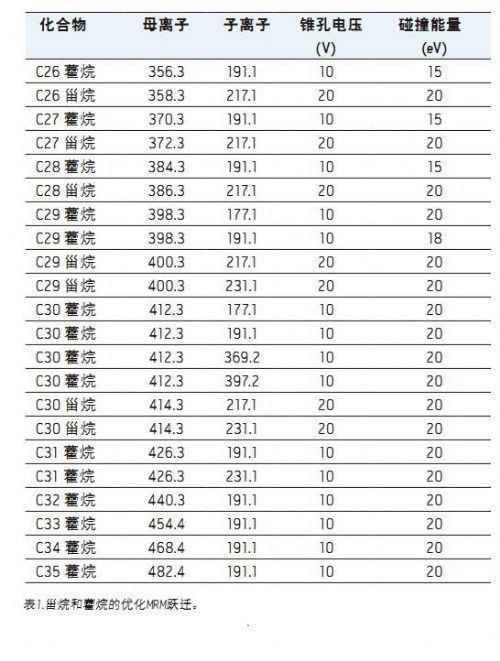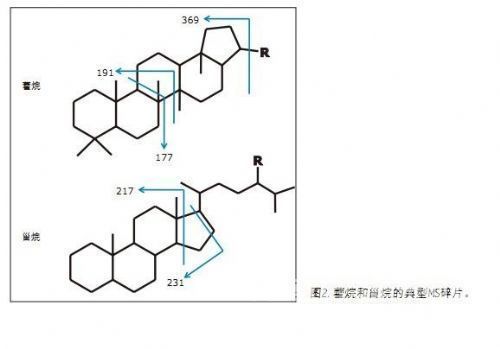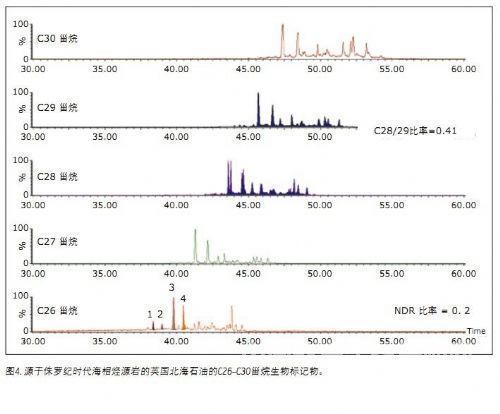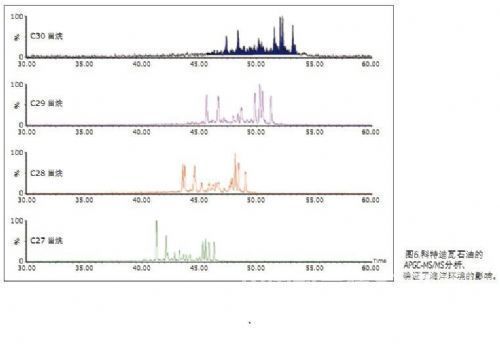Using APGC / MS / MS to analyze petroleum biomarkers in reservoirs for characterization of oil source, oil age, maturity and alteration
Peter Hancock, 1Jody Dunstan, 1Keith Hall, 2Gareth Harriman3
1 Waters Corporation (Manchester, UK)
2Hall Analytical Laboratories Ltd., (Manchester, UK)
3GHGeoChem Ltd., (Liverpool, UK)
Application advantages
The universal ionization source can promote the combination of APGC, UPLC® or UPC2TM on the same MS platform quickly and easily.
APGC is a soft ionization technology that generates a smaller amount of fragment ions than traditional EI. Clearly confirm the sedimentary environment of the reservoir.
Waters Solutions
Atmospheric pressure gas chromatography (APGC)
Xevo® TQ-S
MassLynx® software
Key words
Petroleum, biomarkers, tandem quadrupole, MRM, APGC, sterane, hopane
Introduction
Petroleum exploration and oilfield development depend to a great extent on the knowledge and use of "biomarkers" in crude oil and source rocks to solve problems concerning the origin, storage and evolution history of oil and gas. These "biomarkers" are molecular fossils and can exist stably under geological conditions. They are also equivalent to the "DNA" of petroleum, which can not only provide information on the biological origin of petroleum, but also provide information on the deposition environment of the parent organic matter and the thermal evolution history of the buried organic matter. This information has many uses, especially in upstream applications, and can ultimately associate specific geographic locations with economic productivity. Since the hydrocarbon compounds have not been exposed to the atmosphere (and degraded) or high temperature environment, the biomarkers are stable throughout the geological period. They provide a powerful tool for the study of fingerprints of petroleum and source rocks, and are of great significance for the connection between petroleum and petroleum and its parent source rocks.
Oil may come from a variety of sources, mainly from organic matter deposited in terrestrial or aqueous environments. Terrestrial petroleum comes from substances derived from terrestrial plants, such as coal and resins. Biomarkers will reflect this information using bis-juniperane, indicating resin input, while other biomarkers such as oleanane and lupin are related to flowering plants. The aqueous environment of petroleum includes marine organic matter or lakes (lake environment) contained in shale, carbonate rock and evaporite. Among them, the biomarkers will reflect the source organic matter input and the mineral composition of the source rocks. For example, 24-n-propylcholestane (C30 sterane) is found throughout the marine environment, but it is not found in lakes or continental-derived petroleum. Similarly, a large number of gamma waxes indicate that petroleum source rocks are deposited in environments with high salinity.
experiment
Sample Preparation
Precipitate petroleum samples with excess n-heptane to remove asphaltenes.
GC conditions
System: Agilent 7890 and 7683B autosampler
Column: Restek Rxi-5Sil MS 30 m 0.25 mm, 0.25 m
Carrier gas: Helium, 1 mL / min
Temperature program: Hold at 50 ° C for 2 min, 10 ° C / min to 180 ° C, 2.5 ° C / min to 315 ° C, hold for 11 min
Inlet temperature: 300 ° C
Sampling mode: 1 µL, splitless, 1.5 min vent
Supplementary gas: nitrogen, 400 mL / min Transfer line temperature: 350 ° C
MS conditions
System: Xevo TQ-S
Ionization source: APGC
Corona needle current: 2 µA
Ionization source compensation: 50 V
Source temperature: 150? C
Cone gas: nitrogen, 150 L / hr
Auxiliary gas: nitrogen, 300 L / hr
Acquisition mode: Multiple reaction monitoring (MRM)
Biomarkers have a lower concentration in petroleum and are usually masked by higher levels of n-alkanes. Although petroleum can be analyzed by gas chromatography-mass spectrometry (GC-MS) combined with electron bombardment ion source (EI) in the selected ion scan mode, it must usually be separated into saturated hydrocarbon fractions and aromatic hydrocarbons before analysis Distillate. Even so, if the content of n-alkanes is high in the range of C25 to C35 (biomarkers elute in this area), then n-alkanes need to be removed to
The biomarkers are pre-concentrated. The mass spectrum obtained from these analyses, sterane m / z 217 and hopane m / z 191 were used in the geochemical evaluation of petroleum. Although these analytical methods are very effective, but because the target biomarker content is too low (C26 and C30 steranes) or multiple markers are co-eluted (if the abundance of hopane far exceeds that of steranes, the identification of steranes will be Very difficult) and cause some information to be lost. Due to the complexity of the sample and the relatively low biomarker content, gas chromatography-tandem mass spectrometry (GC-MS / MS) analysis is often required to solve specific geochemical problems. C30 steranes are abundant in marine oil sources. However, the marker content is low and co-eluting with 4-methyl sterane, which means that it can only be accurately detected and quantified using MS / MS.
Just as MS / MS has been shown to improve the results of mass spectrometry analysis of these compounds, the use of atmospheric pressure ionization demonstrates the advantages over EI. Atmospheric pressure gas chromatography (APGC) can generate molecular ion M • +, but its relative abundance is much higher than in EI mode. This improves the selectivity of the first stage of MS and transfers high-abundance molecular ions to the collision cell to achieve controlled fragment dissociation during MS / MS analysis. In contrast, in EI mode only fixed fragment ions and low-abundance molecular ions can be generated. Because EI and APGC use the same form of molecular ion mode under charge exchange conditions, the MRM transitions used for APGC-MS / MS and GC-MS / MS are also beneficial for correlating historical data with results obtained using this new approach United. In this application note, we report a new analytical technique to analyze petroleum biomarkers in source rocks and crude oil by the APGC-MS / MS method.

Results and discussion
The ionization using APGC is similar to atmospheric pressure chemical ionization (APCI) because both can generate molecular ions. APGC is a "soft" ionization technology that generates less debris. The presence of strong molecular ion peaks provides ideal conditions for MS / MS analysis.
Figure 1 shows the comparison between APGC and EI mass spectra of C30 pentacyclic triterpene in marine crude oil. In EI mode, a large number of low-quality fragments can be obtained. This results in fewer precursor ions for MRM transitions and reduced selectivity. If the molecular ion peak is selected as the parent ion, the sensitivity will be reduced. Less fragments were observed in APGC mode, and the molecular ion peak was the base peak. When performing MRM analysis, obtaining high-intensity precursor ions is critical to lower the detection limit.

The content of biomarkers in high-maturity petroleum is low, which requires the use of high-sensitivity and high-selectivity mass spectrometry analyzers to qualitatively and quantitatively quantify such petroleum. Figure 2 shows typical MS fragments of hopane and sterane. MS / MS reduces matrix interference, enabling geochemists to monitor specific precursor ion-product ion transitions to obtain information that GC-MS cannot obtain in SIR mode. Figure 3 shows the elution area of ​​C26 and C30 steranes, revealing the problems associated with these low-abundance components associated with the co-elution of C27-C29 steranes by GC-MS in SIR mode.

One of the most common applications of GC-MS / MS in the analysis of biomarkers is the detection and quantification of steranes. The results obtained can define the following aspects:
1. Determine whether the oil is derived from marine or non-marine phases by evaluating the presence or absence of C30 sterane.
2. Determine the age of oil-producing source rocks by evaluating the ratio of C28 / C29 sterane and C26 sterane.
The example shown in Figure 4 is British North Sea Petroleum derived from Jurassic marine source rocks. By analyzing in MS / MS mode, geochemists can not only confirm their marine origin (the presence of C30 sterane), but also be able to rearrange cholestane or NDR through the C28 / C29 sterane ratio (0.41) and 24-reduced rearrangement The ratio (peak 1 + 2/1 + 2 + 3 + 4 = 0.2) confirms that the oil comes from Jurassic source rocks. The selectivity of MS / MS makes quantification easier because there is no coelution between the components.

Figure 5 shows the GC-MS SIR data of sterane and hopane from Côte d'Ivoire mixed petroleum. The oil contained in the superimposed reservoirs originates from source rocks deposited under marine conditions, but it is also significantly affected by terrestrial organic matter. The detection of biomarkers based on these data first provides an explanation for the terrestrial sources of petroleum, because the large amount of markers contained in petroleum indicates that the parent source rocks are in the sedimentary environment of the river and lake delta. These markers include oleanane (from higher plants) and abundant C29 sterane (from terrestrial plants). C30 sterane can only be identified by APGC-MS / MS. The results are shown in Figure 6, which confirms the impact of the marine environment on the petroleum parent source rocks.


Non-polar GC columns are widely used in the analysis of petroleum biomarkers by GC-MS, and the peak elution before C30 hopane can be obtained through this column, usually identified as oleanane. The precursor ion (m / z 412) of oleanane is the same as C30 hopane, but the retention is weaker. However, lupinane and oleanane have the same mass number and very similar mass spectra, except that they have m / z 369 product ions. Currently, little is known about the importance of lupin as a geochemical marker, largely because it is often regarded as oleanane. These compounds can be fully separated by reverse-phase HPLC, but if you want to use a single analysis system, APGC-MS / MS is the first choice. It can determine whether the peak eluting before C30 hopane is oleanane or lupin . Fig. 7 shows an example of a fraction having a peak flowing out before C30 hopane. By monitoring the second transition, we can easily see that in the same protection
There is no peak outflow at the retention time. This indicates that the analysis sample contained only oleanane and no lupin.
in conclusion
APGC is a soft ionization technology that generates fewer fragment ions than traditional EI. APGC operates under dry conditions and usually generates a mass spectrum of strong radical cation molecular ion peaks, which is beneficial for direct comparison with EI databases from different sources. The richness of these ions and the MRM transition mode contribute to the greater specificity and sensitivity of petroleum biomarkers, thereby providing information about the biological source of petroleum, the deposition environment of parent organic matter, and the thermal evolution history of buried organic matter. This information is very useful in upstream applications, and can ultimately associate specific geographic locations with economic productivity.
All Waters instruments are equipped with a universal ionization source that facilitates the quick and easy use of APGC, UPLC or UPC2 on the same MS platform. The combination of APGC and Xevo TQ-S can quantify low-level petroleum biomarkers to clearly confirm the sedimentary environment of the reservoir, which is difficult for the GC-MS system to achieve.
references
1. AG Holba, LIP Dzou, WD Masterson, WB Hughes, B Huizinga, MM
Singletary, M Moldowan, MR Mello, and EW Tegelaar. (1998). Application of
24-norcholestanes for constraining source age of petroleum. In: Advances in
Organic Geochemistry 1997. Proceedings of the 18th International Meeting,
Maastricht NL. September 22-26. Vol. Part II Biogeochemistry, Pergamon
Press & EAOG pp. 1269-1284: Org. Geochem V.29 Nos. 5/7.
2. HP Nytoft, A Jorgen, B Koefoed, FG Christiansen, MG Fowler. Oleanane or
Lupane? Reappraisal of the presence of oleanane in Cretaceous-Tertiary oils
and sediments. In: Org. Geochem 33: 1225-1240, 2002.
3. KE Peters, CC Walters, JM Moldowan. The Biomarker Guide. Cambridge
University Press ISBN: 0 521 83763 4, 2005.
Download the complete PDF document: http: //? Lid = 134730757 & cid = 134528340 & locale = zh_CN
Makeup Brush Mermaid,Natural Makeup Brushes,Fan Makeup Brush,17Pcs Brush Set
DONGGUAN YACAI COSMETICS CO.,LTD. , https://www.yacaicosmetic.com